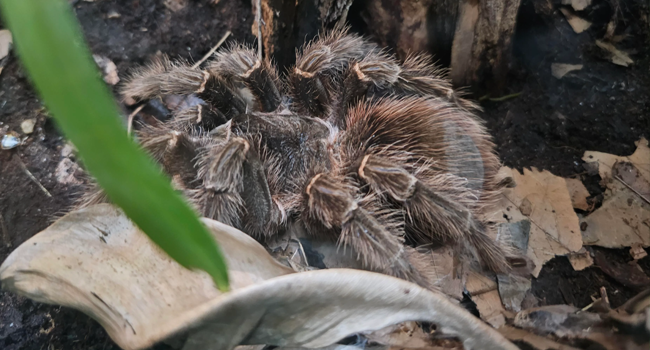Tarantulas, often feared and misunderstood, are fascinating creatures that captivate the hearts of many arachnid enthusiasts. While they might appear intimidating, creating the perfect enclosure for your tarantula can provide a safe and comfortable environment for these eight-legged wonders.
Introduction to Tarantula Habitat
Tarantulas are a diverse group of spiders known for their large size, varying colors, and unique behaviors. They are kept as pets by individuals who appreciate their intriguing characteristics. However, to ensure the well-being of your tarantula, it’s crucial to replicate their natural habitat as closely as possible.
Importance of Creating the Perfect Enclosure
The environment in which a tarantula lives has a direct impact on its health and overall demeanor. A well-designed enclosure is essential for providing comfort, security, and stimulating natural behaviors. Let’s delve into the specifics.
Understanding Tarantula Habitat Requirements
- Temperature and Humidity
Maintaining the optimum temperature and humidity levels is necessary. Different tarantula species have varying requirements, so research your specific tarantula to meet their needs accurately.
- Substrate
Selecting the appropriate substrate is essential to simulate the natural ground of the tarantula’s habitat. Ensure it’s deep enough to allow burrowing if your tarantula is a species that enjoys digging.
- Hideouts and Decorations
Adding shelters and decorations not only enhances the aesthetic appeal but also provides hiding spots and climbing opportunities for your tarantula.
Choosing the Right Enclosure
Choosing the right enclosure size is crucial. Ensure it’s spacious enough for your tarantula to move comfortably but not so large that it creates stress. Glass or plastic enclosures are common choices.
Setting Up the Tarantula Enclosure
- Substrate Layering
Create layers in the substrate, with the deepest part in the center. This provides an opportunity for your tarantula to dig its burrow if desired.
- Furnishing the Enclosure
Add branches, rocks, or artificial plants for your tarantula to explore. Ensure they are securely placed to prevent injuries.
Maintaining the Habitat
Regularly clean the enclosure by removing waste and uneaten food. Maintain optimal humidity levels and clean the water dish to prevent mold or bacteria growth.
Feeding and Hydration
Tarantulas are primarily carnivorous. Feed them a diet of live insects, and ensure a clean water source is always available. The feeding frequency varies by species, so research your tarantula’s needs.
Common Mistakes to Avoid
Avoid common mistakes like overhandling your tarantula, providing inadequate ventilation, or using toxic decorations. Such errors can be detrimental to your tarantula’s health and well-being.
Breeding Tarantulas
Breeding tarantulas can be a rewarding but challenging endeavor. If you’re interested in breeding, it’s crucial to gain knowledge and experience. Here are some key points to consider:
- Species Compatibility
Ensure you have a male and female of the same species and that they are sexually mature. Mating different species may lead to conflicts or hybridization.
- Mating Process
The mating process can be delicate, as the female might view the male as a potential meal. Introduce the male to the female’s enclosure cautiously and be prepared to separate them if necessary.
- Egg Sac Care
If the mating is successful, the female will produce an egg sac. Keep the egg sac in a controlled environment with stable temperature and humidity until the spiderlings hatch.
- Rearing Spiderlings
Rearing spiderlings is a meticulous task. You’ll need to provide tiny food items, like fruit flies or pinhead crickets, and monitor their development closely.
Maintaining a Healthy Tarantula
Once you’ve set up the ideal habitat for your tarantula, it’s essential to focus on maintaining their health and well-being. This involves several key aspects:
- Observation
Regularly observe your tarantula. A healthy tarantula will appear active, move about its enclosure, and display a consistent appearance. Any significant changes in behavior or physical condition should be monitored closely.
- Feeding Schedule
As mentioned earlier, feeding frequency varies by species. Some tarantulas may eat once a week, while others may require less frequent feedings. Be patient and attentive to your tarantula’s specific dietary needs.
- Hydration
Ensure that your tarantula always has access to clean, fresh water. A small, shallow dish is sufficient.
- Cleaning the Enclosure
Regularly remove uneaten food, molting exoskeletons, and waste from the enclosure. Keeping the environment clean helps prevent the growth of harmful microorganisms and maintains a healthy living space.
- Molting
Tarantulas molt periodically, shedding their exoskeleton to grow. During this process, they are vulnerable, and it’s crucial to provide a stress-free environment. Ensure they have a suitable hiding place, and don’t disturb them during molting.
Tarantulas and the Environment
Tarantulas play a vital role in the ecosystem by controlling insect populations. They are excellent natural pest controllers. However, it’s essential to understand the legality of keeping tarantulas as pets in your area and to consider ethical sources when acquiring them.
Tarantula Communities
Connecting with fellow Tarantula enthusiasts can be a valuable resource for information and support. Online forums, social media groups, and local reptile and arachnid clubs are excellent places to share experiences, ask questions, and learn about tarantulas.
Tarantula Health Concerns
While tarantulas are generally hardy creatures, there are a few health concerns to be aware of:
- Parasites and Infections
Watch for signs of parasites or infections, such as lethargy, loss of appetite, and unusual growths on the tarantula’s body. I
- Stress
Stress can adversely affect your tarantula’s health. Limit handling to a minimum, provide adequate hiding spots, and avoid loud noises or sudden disturbances in the environment.
- Handling
Tarantulas should be handled sparingly. While some species are more tolerant of handling, it’s best to limit it to reduce the risk of injury to both the tarantula and the handler.
Conclusion
Creating the perfect enclosure for your tarantula is a rewarding endeavor. Not only does it provide a safe and comfortable home for your pet, but it also allows you to observe their fascinating behaviors up close. By understanding their specific needs, you can ensure that your tarantula thrives in captivity.
Remember to research your tarantula’s species and habitat requirements thoroughly. Consistently provide the correct temperature, humidity, substrate, and decorations, and maintain a healthy feeding and hydration schedule. Regular observation and cleanliness are crucial to your tarantula’s well-being. And, most importantly, enjoy the experience of caring for these remarkable arachnids.
So, whether you’re a seasoned tarantula enthusiast or just beginning your journey with these intriguing creatures, creating the perfect tarantula habitat is a fulfilling and educational experience.
Frequently Asked Questions (FAQs)
-
Can tarantulas be kept in groups, or should they be housed individually?
Most tarantulas are solitary creatures and should be housed individually. Exceptions are rare and depend on the specific species.
-
How do I use my tarantula?
Sexing tarantulas can be challenging and often requires the expertise of experienced hobbyists or breeders. It typically involves examining the molted exoskeleton.
-
Are all tarantulas venomous to humans?
While most tarantulas possess venom, most species have venom that is not harmful to humans. However, some species, such as the “Old World” tarantulas, can deliver more potent bites.
-
Can tarantulas be kept by beginners as pets?
Some tarantula species are more suitable for beginners due to their docile nature and ease of care. Research and choose a beginner-friendly species if you are new to tarantula keeping.
-
What is the average lifespan of a tarantula?
Tarantula lifespans vary by species. On average, they can live anywhere from 5 to 20 years, with some species surpassing that range.







